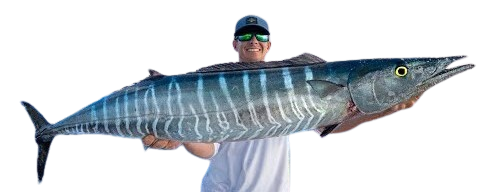Ono Fish, or Wahoo, is one of the fastest-growing fish species and one of the most popular worldwide fish species to eat. Their body is torpedo-shaped, and the color of this fish is blue-green. The wahoo is a good-looking fish, and it is also a tough fish for a fisherman to catch. Wahoos can strike at speeds of up to 60 mph and, when hooked, are reported to be tough fighters, leaping repeatedly from the water, making them a good target for anglers.

Habitat and Distribution
The presence of whales can be recorded in tropical as well as subtropical regions of the oceans and seas of the world, especially in the Atlantic, Indian, and Pacific Oceans. They are commonly found in the upper, middle, and lower water columns, in water depths of 150 to 500 feet, and are commonly seen in association with floating objects such as debris or weed lines where the small fish and squid that make up their diet congregate. In Hawaii, wahoos are distributed around the territories deep edges and offshore seamounts and are tangible in the course of the year but are predominant between June and October.
Physical Characteristics
Wahoo fish are characterized by a long, fusiform body with very powerful jaws armed with sharp teeth, thus perfectly suited to a predatory existence. The body colouration of this fish is blue-green on the dorsal side of the fish, silvery on the lateral sides, and white on the ventral side. Vertical blue bars are clearly observed on the sides of wahoos, but these may not be clearly visible after they are dead. These possess jaws filled with teeth adapted for cutting, which enable them to feed on all sorts of smaller fish, squids, and crustaceans.

Speed and Hunting Behavior
Male wahoos are among the fastest fish in the whole world, and these fish may swim at astonishing speeds of up to 60 mph for a short distance. This incredible speed is not only an aspect of the cheetah’s defense but also enables the cheetah to catch fast animals. Wahoos are carnivorous and are mostly seen hunting alone, but at times in groups of 2–3 individuals. Their hunting approach is to approach schools of smaller fish quickly and launch very forceful attacks on the fish.
Fishing Techniques
Because of the agility of these fishes, people love to catch them and therefore Wahoos are categorized as game fishes. Trolling can be done in high speeds and is one of the most effective techniques of catching Wahoos. This technique involves trailing baits or lures behind the boat at speeds of between 10 and 20 knots.
The wahoos get attracted to the technique of moving lures since it have the appearance of baits that are run up by their potential prey. Another common practice is live baiting, Wahoos can be attracted using live fish for instance, mackerel or bonito. Due to large, sharp teeth, the use of wire leaders during the fight and landing of the fish is necessary to avoid fish loss due to bite-off.

Culinary Value
Besides being a game fish, Wahoos are renowned for their good taste and therefore valued for their quality of meat. The meat of a Wahoo is pale, smooth and has a delicate taste The texture is like that of tuna or mackerel. It has little fat but is high in protein, which is ideal for preparation in many different ways. Wahoos can be grilled, baked, or seared and are, therefore, common in Sushi and Sashimi because of their bland taste.
Conservation and Management
Wahoos are described in terms of least concern as far as they are concerned with the conservation of species, yet harvest practices should still be protective for their benefit. Some of the factors that threaten Wahoo’s existence include overexploitation associated with high fishing effort levels. Some form of fishing quotas and sizes of fish caught are applied in some areas in an effort to regulate Wahoo population. Fishermen are advised to be careful whenever they are out angling to avoid catching small fish and to obey the laws of the country, i.e state that they are in.
The Wahoo Experience
Wahoo is also considered a trophy fish by many fishermen and catching one is definitely on any fisherman’s wish list. It’s a muscular fish, fast, sleek and beautiful, and the experience of reeling it in is therefore a memorable one out on the water. Whether someone is at sea fishing for Wahoo or eating at a restaurant that serves Wahoo grilled fillet, this aplacian fish keeps astounding those who come across it. They jump, they fight fiercely, and they give tremendous pound-for-pound factor and all these make the Wahoo one fish to look forward catching in the world ocean.
In summary, the Wahoo (Ono) is much more than just another fish in the sea. It’s a symbol of the challenges and rewards that come with sport fishing, a culinary delight, and a reminder of the importance of sustainable fishing practices to preserve these incredible creatures for future generations.
Best Fishing Lures for Wahoo Fishing
When targeting wahoo, also known as ono, some of the best fishing lures include:
- High-Speed Trolling Lures: Such are the spoons such as Yozuri Bonita, Rapala X-Rap Magnum, and Nomad DTX Minnow, which are meant to be trolled at a wake of between 12 and 20 kts.
- Jet Head Lures: These lures, such as the Iland Ilander and Williamson Speed Pro Deep, create a bubble trail that attracts Wahoo.
- Weighted Skirts and Feather Jigs: These can be effective when trolled fast or used as drop-back lures. The Zuker ZF series is a popular choice.
- Metal Jigs: Heavy metal jigs like the Williamson Benthos Speed Jig are great for vertical jigging and work well for deep-water wahoo fishing.
These lures resemble the speed at which prey move, and the Wahoo are known to pursue with a lot of speed, hence ideal for the purpose.

Why is Mackerel Fish called Ono Fish in Hawaii?
This is actually a Wahoo fish, not the Mackerel, as they refer to it as “Ono” in Hawaii. The name “Ono” in Hawaiian relates to tasty fish that competed with the present fish in terms of flavour and softness. Mackerel is another type of fish, but it is not given the name “Ono” in Hawaii. Wahoo is usually acknowledged as ‘Ono’ and is loved by both locals and tourists; it has tender white meat and a mildly conditioned taste.
Is an Ono a Barracuda?
Ono is not a barracuda; he was selected because he is well-mannered and funny. A derived term, ono, is used to refer to the Wahoo fish, which is a different fish from the barracuda. The Regional Wahoos are also fast-moving fish and have elongated, shaped, and sharp teeth similar to those of barracuda, but they belong to different family groups of fish.
Wahoos are from the Scombridae family, and barracudas are from the Sphyraenidae family. Although there are some similarities in their physical characteristics, they are different species that have dissimilar ways of life and the places where they are found.
Frequently Asked Questions about Ono Fish
- What is the difference between Ono Fish and Wahoo?
- Ono Fish is simply the Hawaiian name for Wahoo. Both refer to the same species, known for its speed and prized for its mild, firm flesh.
- What’s the best time to catch Ono Fish in Hawaii?
- The best time is typically from June to October, when they are most abundant around the Hawaiian Islands.
- Can Ono Fish be eaten raw?
- Yes, Ono Fish is often used in sushi and sashimi due to its delicate flavor and firm texture.
- How fast can an Ono Fish swim?
- Ono Fish are among the fastest in the ocean, capable of reaching speeds up to 60 mph.
- What’s the most effective way to catch Ono Fish?
- High-speed trolling is the most effective method, using lures that mimic fast-moving prey.

